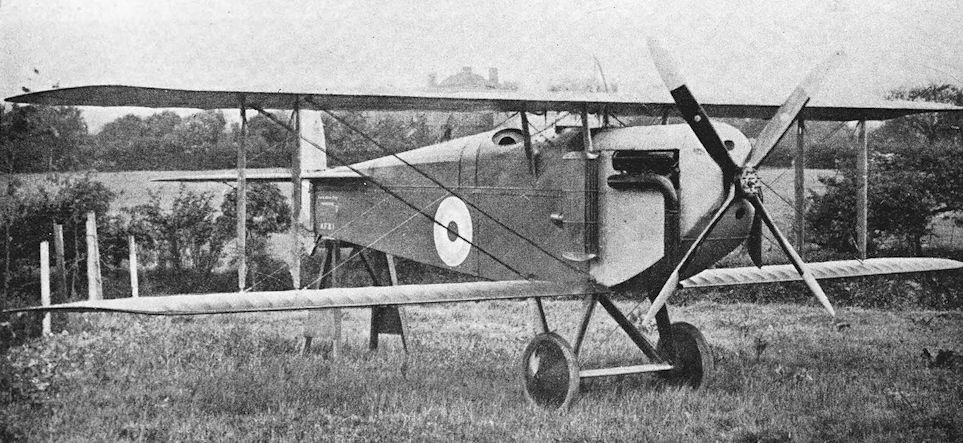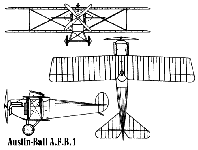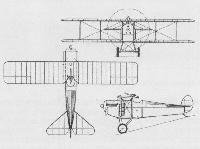P.Lewis The British Fighter since 1912 (Putnam)
Often alternative combinations of armament were experimented with on the squadrons but only comparatively rarely did a pilot fighting at the Front have a direct say in the design of a fighter aircraft itself. One such case was in the Austin-Ball A.F.B.1 single-seat biplane which was finished in July, 1917. Until the time of his death in action on 7th May, 1917, Ball had kept in direct touch with the evolution of the A.F.B.1. Although an ugly machine, its saving grace was a maximum speed of 138 m.p.h. at ground level on the 200 h.p. of its Hispano-Suiza engine and a good performance in rate of climb and ceiling. The installation of the A.F.B.1’s pair of Lewis guns was of note; that in the fuselage fired through the centre of the propeller shaft, while the other occupied a Foster mounting on the upper centre-section. Despite its abilities the machine was not selected finally for production.
Показать полностью
F.Mason The British Fighter since 1912 (Putnam)
Austin-Ball A.F.B.1
Captain Albert Ball was still only nineteen years of age in April 1916, while flying B.E.2Cs on reconnaissance flights over the Western Front with No 13 Squadron, RFC. In a letter, written that month to his parents he tells of his idea for an aircraft ‘better than the Fokker’. Several months later, while on leave in England, Ball met representatives of the Austin Motor Company, who in turn approached the Air Board to seek an order to build two examples of Ball’s aircraft. It was, however, Ball himself who secured the order by going straight to Maj-Gen Sefton Brancker, Director of Air Organisation.
It is a quirk of irony that, when Ball expressed his first ideas for his fighter, he had not yet been in combat, yet by the time the Austin-Ball A.F.B.1 was ready for flight in July 1917, the young pilot had been dead for two months - killed on active service on 7 May after gaining a total of 44 air victories and being awarded the Victoria Cross, three DSOs and the MC, all before his 21st birthday.
Ball’s aircraft reflected his particular style of combat, a fast single-seater and an upward-firing gun with which to rake an enemy aircraft from below. It was a portly, single-bay biplane, powered by the 200hp Hispano-Suiza, and armed with one Lewis gun firing through the hollow propeller shaft and another on a Foster mounting on the upper wing. A well-shaped nose cowling was made possible by mounting the engine radiators on the fuselage sides, while the deep fuselage allowed the top wing to be located close to the fuselage - thereby providing the pilot with an excellent field of view over the wing, and at the same time retaining a good wing gap. The only significant criticism levelled at the design concerned the absence of a fixed tail fin, a deficiency that was evidenced by poor lateral control, although the rudder was balanced.
When first tested at Martlesham Heath in July 1917, the un-numbered A.F.B.1 returned the excellent top speed of 138 mph at sea level, and could reach 10,000 feet in under nine minutes. While this performance was at least comparable with that of the the S.E.5A, and superior to the Camel, the forward armament of a hub-firing Lewis gun - though radical by 1916 standards - was not favoured in an era of twin synchronized Vickers. Nevertheless, there was more irony in the fact that Ball never became fully reconciled with the S.E.5 (preferring the nimble Nieuport), yet his aircraft was clearly conceived along similar lines. Moreover there is some circumstantial evidence to suggest that it was in recognition of Austin’s perseverence with the A.F.B.1 that the company was awarded a huge production contract - for over 800 S.E.5As!
Type: Single-engine, single-seat, single-bay biplane fighting scout.
Manufacturer: The Austin Motor Co (1914) Ltd, Birmingham.
Powerplant: One 200hp Hispano-Suiza engine driving four-blade propeller.
Dimensions: Span, 30ft 0in; length, 21ft 6in; height, 9ft 3in; wing area, 290 sq ft.
Weights: Tare, 1,525lb; all-up, 2,077lb.
Performance: Max speed, 138 mph at sea level; climb to 10,000ft, 8 min 55 sec; service ceiling, 22,000ft; endurance, 2 1/4 hr.
Armament: One 0.303in Lewis machine gun firing through hollow propeller shaft, and one Lewis gun on Foster mounting on upper wing centre section.
Prototype: Two A.F.B.1s were ordered, but it is believed that the second was not completed. No production.
Показать полностью
W.Green, G.Swanborough The Complete Book of Fighters
AUSTIN A.F.B.1 UK
Frequently referred to as the "Austin Ball Scout" because the Austin Motor Company incorporated some of the ideas of Capt Albert Ball, VC, DSO, MC, in this fighter’s design, the A.E.B.1 was designed by C H Brooks and was flown for the first time in July 1917. It was of wooden construction with fabric covering, and was powered by a 200 hp Hispano-Suiza eight-cylinder liquid-cooled engine. Armament comprised a single 0.303-in (7,7-mm) Lewis machine gun firing through the hollow propeller shaft, and a similar weapon on a Foster mounting above the upper wing centre section. As originally built, the sole prototype of the A.E.B.1 had slightly sweptback wing surfaces and conventional single-bay bracing, but during the course of development new unswept surfaces accompanied by revised interplane bracing of two-bay form were introduced. The aircraft flew for the first time after these modifications on 17 September 1917. The following data relate to the A.E.B.1 in its original form.
Max speed, 138 mph (222 km/h) at sea level, 120 mph (193 km/h) at 15, 000 ft (4 570 m).
Time to 10,000 ft (3 050 m), 8.9 min.
Endurance, 2.25 hrs.
Empty weight, 1,525 lb (692 kg).
Loaded weight, 2,077 lb (942 kg).
Span, 30ft 0 in (9,14 m).
Length, 21 ft 6 in (6,55 m).
Height, 9 ft 3 in (2,82 m).
Wing area, 290 sq ft (26,94 m2).
Показать полностью
J.Bruce British Aeroplanes 1914-1918 (Putnam)
Austin-Ball A.F.B.1.
THE Austin-Ball A.F.B.1 was a single-seat fighting scout designed to the ideas of Captain Albert Ball, V.C., D.S.O., M.C., and represented his conception of the ideal single-seat fighter. At the beginning of April, 1916, Ball wrote home in the following enthusiastic terms:
“I have the plans now of a most wonderful machine. It will be heaps better than the Hun Fokker. I have been to the Major and he has given me full permission to fly it if I can get one out. I know that it will be a fine thing.”
On his first leave, Ball took the plans home with him and spent the winter of 1916-17 in trying to arrange for the construction of the machine, which was to be made by the Austin Motor Company. Early in 1917, while in London, Ball met a representative of the firm who was greatly discouraged at having failed to interest the Air Board in the Austin-Ball Scout. Ball went straight to Brigadier-General Sefton Brancker, then Director of Air Organisation, and made such strong representations that he came away with an order to build two machines at once and the promise that, if they were built in time and proved to be successful, a large production order would be placed.
The Austin-Ball A.F.B. 1 was characterised by an unusually deep fuselage which almost completely filled the gap between the mainplanes. The upper mainplane was at the level of the pilot’s eyes and he therefore had an excellent view all round the upper hemisphere. The mainplanes were swept back slightly, but were rigged with neither stagger nor dihedral. No fixed fin was fitted; and the rudder, of a pleasing oval shape, looked surprisingly small. The A.F.B.i was a thoroughly workmanlike aeroplane in every way, and its most remarkable feature lay in the disposition of its armament.
Ball gained most of his victories while flying a Nieuport Scout, and one of his favourite methods of attack was to stalk his victim from behind and below, gradually coming up under his enemy’s blind spot. Once in the position he favoured, Ball would let down his Lewis gun to the lower limit of its travel on the rail of its Foster mounting, and a short no-deflection burst of fire sufficed to despatch the enemy machine. It was, of course, a simple matter for Ball to rake the victim from nose to tail by a small back-and-forward movement of the stick. He used this same form of attack when he later flew S.E.5s.
It comes as no surprise, therefore, to learn that one of the Austin-Ball Scout’s Lewis guns was fitted to a Foster mounting on the upper wing. As on the Nieuport, this Lewis was mounted at an angle above the horizontal. But the installation of the A.F.B. 1’s other Lewis gun represented a radical departure from contemporary practice, for it was arranged to fire forward through the hollow airscrew shaft in the manner of latter-day moteurs-canons.
This may well have been the first instance of this particular method of mounting an aeroplane weapon, and was a commendable attempt to provide a gun on a tractor aeroplane firing forward along the line of flight. If Ball had the plans of the machine in April, 1916, it must have been designed some time before that date. The first British aeroplane fitted with a gun synchronising gear (a Bristol Scout with the Vickers mechanical gear) reached France only on March 25th, 1916; but whether the A.F.B.1’s armament installation was designed in ignorance of the existence of a British interrupter gear, or simply to avoid the use of such a gear, will probably never be known. It may well be that Ball preferred the Lewis to the Vickers gun: the Lewis, although a simpler weapon mechanically, was less well suited to firing with synchronising or interrupter gears. In the A.F.B.1 the breech of the lower Lewis gun projected backwards into the cockpit, where it was ideally accessible for reloading and stoppage-clearance.
Owing to the delays experienced in the machine’s design stages, it was not until July, 1917, two months after Ball’s death, that the A.F.B.1 was ready for testing. By that time the S.E.5 and Sopwith Camel were well into large-scale production and in squadron service in ever-increasing numbers. The A.F.B.1’s performance was startling, and it was described as comfortable to handle although its lateral control could have been better. However, the Air Board did not consider its superiority over the machines then in production to be great enough to justify interference with existing production plans, and the type was not developed further.
SPECIFICATION
Manufacturers: The Austin Motor Co. (1914), Ltd., Northfield, Birmingham.
Power: 200 h.p. Hispano-Suiza. Engines Nos. W.D.8302 and W.D.8354 were fitted.
Dimensions: Span: 30 ft. Length: 21 ft 6 in. Height: 9 ft 3 in. Chord: 5 ft. Gap: 4 ft 9 in. Stagger: nil. Dihedral: nil. Incidence: 2°. Span of tail: 11 ft 3 in. Tyres: 700 X 75 mm. Airscrew: (i) Grahame-White No. 512 - diameter 9 ft 6 in., pitch 7 ft 3 in. (ii) Tibbenham T.28097, No. 4205 - diameter 7 ft 9 in., pitch 10 ft 6 in. (iii) Vickers Series No. 192 - diameter 8 ft.
Areas: Wings: 290 sq ft. Ailerons: each 7-5 sq ft, total 30 sq ft. Tailplane: 16 sq ft. Elevators: 16 sq ft. Rudder: 8 sq ft.
Weights: Empty (with water): 1,525 lb. Military load: 87 lb. Pilot: 180 lb. Fuel and oil: 285 lb. Loaded: 2,077 lb.
Performance: No. of Trial Report M.122 M.122 M.122
Date of Trial Report July, 1917 July, 1917 July, 1917
Maximum speed (m.p.h.)
at ground level 138 - -
6,500 ft - 119 -
10,000 ft 126'5 115'5 118
12,000 ft 124 - -
13,000 ft 123 112 -
15,000 ft 120'5 - -
16,500 ft 118'5 - -
19,000 ft 114-5 - -
m. s. m. s. m. s.
Climb to
1,000 ft 0 40 - - - -
6,000 ft 4 45 - - - -
6,500 ft - - 8 25 6 35
10,000 ft 8 55 15 15 11 45
14,000 ft 14 30 - - - -
18,000 ft 23 00 - - - -
20,000 ft 29 55 - - - -
Service ceiling (feet) 22,000 16,000 17,000
Endurance 2 1/4 hours at full speed at 10,000 ft
Tankage:
Petrol:
Top (pressure) tank 9 gallons
Bottom (pressure) tank 20 gallons
Service (gravity) tank 3 gallons
Total 32 gallons
Oil 5 gallons
Water 9 gallons
Armament: Two Lewis machine-guns, one fixed to fire forwards through the hollow airscrew shaft, the other on a Foster mounting above the upper wing firing forwards and upwards over the airscrew.
Production: Two Austin-Ball A.F.B.1s were ordered under Contract No. 87/A/1524, but it is uncertain whether the second machine was completed.
Показать полностью
H.King Armament of British Aircraft (Putnam)
Austin-Ball A.F.B. 1. Apparently at the suggestion of Capt Albert Ball, vc, DSO, MC, this single-seater of 1917 had a Lewis gun on a special mounting for upward tiring only (a form of attack which Ball favoured), and, of greater interest, a second Lewis gun lying between the cylinder blocks of the Hispano-Suiza engine and firing through the airscrew shaft. An existing photograph shows the external Lewis gun, which was mounted at an angle and pointed through the airscrew arc when at its lowest position, with the 'single' (47-round) drum.
Показать полностью









